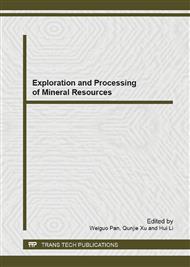[1]
Ameen, M., MacPherson, k., Al-Marhoon, M., Rahim, Z., 2012. Diverse fracture properties and their impact on performance in conventional and tight-gas reservoirs, Saudi Arabia: The Unayzah, South Haradh case study. AAPG Bulletin, 96, 459-492. DOI: 10. 1306/06011110148.
DOI: 10.1306/06011110148
Google Scholar
[2]
Brincat, M., Gartrell, A., Lisk, M., Bailey, W., Johnson, L., Dewhurst, D., 2006. An integrated evaluation of hydrocarbon charge and retention at the Griffin, Chinook, and Scindian oil and gas fields, Barrow Subbasin, North West Shelf, Australia. AAPG Bulletin, 90, 1359-1380. doi: 10. 1306/02210605103.
DOI: 10.1306/02210605103
Google Scholar
[3]
Coleman, J., 2008. Tight-gas sandstone reservoirs: 25 years of searching for the answer', in S. P. Cumella, K. W. Shanley, and W. K. Camp, eds., Understanding, exploring, and developing tight-gas sands — 2005 Vail Hedberg Conference. AAPG Hedberg Series, 3, 221-250.
DOI: 10.1306/13131058h31008
Google Scholar
[4]
George, S. C., Volk, H., Ahmed, M., 2007. Geochemical analysis techniques and geological applications of oil-bearing fluid inclusions, with some Australian case studies. Journal of Petroleum Science and Engineering, 57, 119-138. doi: 10. 1016/j. petrol. 2005. 10. 010.
DOI: 10.1016/j.petrol.2005.10.010
Google Scholar
[5]
Jonk, R., Parnell, J., Whitham, A., 2005. Fluid inclusion evidence for a Cretaceouse-Paleocene petroleum system, Kangerlussuaq Basin, East Greenland. Marine and Petroleum Geology 22, 319-330.
DOI: 10.1016/j.marpetgeo.2005.01.002
Google Scholar
[6]
Kuang, L., Heng, H., Wang, M., Huang, T., Liu, C., 2010. Timing and mechanism of reservoir forming in the Upper Triassic Halahatang Formation, Yuqi block, Tarim Basin, northwestern China. Marine and Petroleum Geology 27, 1830-1840.
DOI: 10.1016/j.marpetgeo.2010.08.004
Google Scholar
[7]
Law, B. E., 2002. Basin-centered gas system [J]. AAPG Bulletin 86, 1891-(1919).
Google Scholar
[8]
Milliken, K., 2001. Diagenetic heterogeneity in sandstone at the outcrop scale, Breathitt Formation (Pennsylvanian), eastern Kentucky. AAPG Bulletin 85, 795-815.
DOI: 10.1306/8626ca05-173b-11d7-8645000102c1865d
Google Scholar
[9]
Nelson, P., 2009. Pore-throat sizes in sandstones, tight sandstones, and shales. AAPG Bulletin 93, 329- 340.
DOI: 10.1306/10240808059
Google Scholar
[10]
Nelson, P., 2011. Pore-throat sizes in sandstones, siltstones, and shales: Reply. AAPG Bulletin 95, 1448-1453.
DOI: 10.1306/12141010159
Google Scholar


